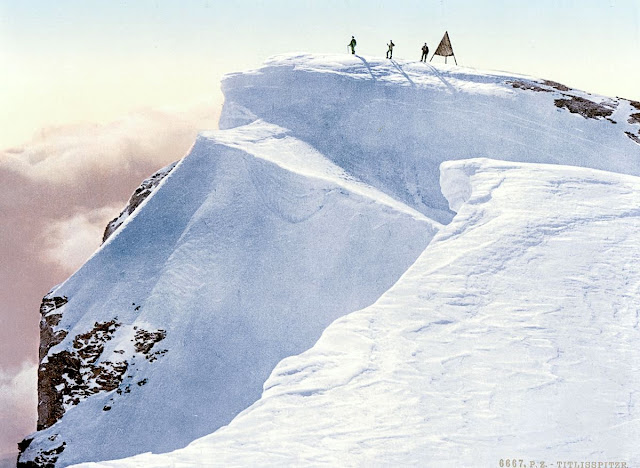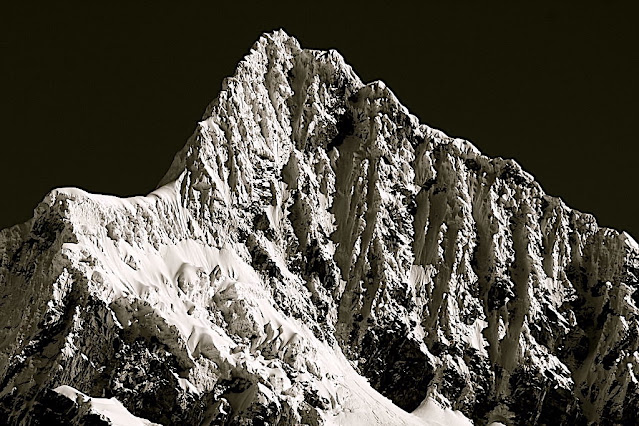La montagne
L'Alpspitze (2,628 m - 8,622ft) est une montagne de Bavière, en Allemagne. Son sommet pyramidal connu sous le nom de Montagne Bleue, est le symbole de Garmisch-Partenkirchen et l'un des plus repérables des Alpes du Nord. Il est constitué principalement de calcaire de Wetterstein du Trias supérieur.
Plusieurs routes permettent l'ascension de l'Alpspitze. La plus courte commence à la station d'Osterfelderkopf (2 033 m) au téléphérique Alpspitze de Garmisch-Partenkirchen. Depuis l'Osterfelderkopf, l'Alpspitze peut être escaladé soit directement le long de l'Alpspitz-Ferrata, une route facile, protégée et très fréquentée (à environ 2 heures de l'Osterfelderkopf), soit le sommet peut être atteint par la montée de la face nord (Nordwandsteig), qui tourne en courbe vers l'est dans le cirque d'Oberkar et de là longe le bord gauche du cirque jusqu'au sommet.
Une autre ascension part du col de Grießkarscharte (2 460 m), que l'on atteint soit depuis le refuge Höllentalanger dans la vallée de Höllental via le cirque de Mathaisenkar soit depuis le lac de Stuibensee via le cirque de Grießkar.
Le peintre
Wassily Wassilyevich Kandinsky (Васи́лий Васи́льевич Канди́нский) était un peintre franco-russe et théoricien de l'art. On lui attribue la peinture de l'une des premières œuvres purement abstraites reconnues. Né à Moscou, Kandinsky a passé son enfance à Odessa, où il est diplômé de l'école d'art Grekov. Il s'est inscrit à l'Université de Moscou, étudiant le droit et l'économie. Il se voit rapidement offrir une chaire de professeur (chaire de droit romain) à l'Université de Dorpat. Kandinsky commence des études de peinture (dessin d'après nature, croquis et anatomie) à l'âge de 30 ans.
En 1896, Kandinsky s'installe à Munich, étudiant d'abord à l'école privée d'Anton Ažbe puis à l'Académie des Beaux-Arts.
Entre 1906 à 1908, il voyagea beaucoup à travers l'Europe jusqu'à ce qu'il s'installe dans la petite ville bavaroise de Murnau. En 1908, il acheta un exemplaire de Thought-Forms d'Annie Besant et de Charles Webster Leadbeater. En 1909, il rejoint la Société Théosophique.
La Montagne bleue (1908-1909) - on devrait dire d'ailleurs LES montagnes bleue car il a peint plusieurs ce même sujet à cette époque - montre sa nette évolution vers l'abstraction en moins de deux années. La large utilisation de la couleur dans ces tableaux illustre l'inclination de Kandinsky vers un art dans lequel la couleur commence à s'affranchir de la forme, et où chaque couleur est représenté avec la même attention, la même importance.
Après le déclenchement de la Première Guerre mondiale, Kandinsky quitte l'Allemagne pour Moscou. Indifférent aux théories officielles sur l'art dans la Russie communiste, il rentre rapidement en Allemagne en 1920, quelques années après la Révolution. Là, il a enseigné à l'école d'art et d'architecture du Bauhaus de 1922 jusqu'à ce que les nazis la ferment en 1933. Il s'installe ensuite en France, où il vécut pour le reste de sa vie, devenant citoyen français en 1939 et produisant certains de ses plus art de premier plan. Il meurt à Neuilly-sur-Seine en 1944.
_________________________________________
2023 - Wandering Vertexes ....
Errant au-dessus des Sommets Silencieux...
Un blog de Francis Rousseau
%20Winter%20Landscape%20(Blue%20Mounbtain%20%3F%20Murnau%20%3F%20(1909)%20Oil%20on%20cardboard,%2070%20x%2097%20cm.%20The%20Hermitage%20Museum,%20Saint%20Petersburg.jpg)

%20-The%20Ramparts,%20Tonquin%20Valley,%20Rocky%20Mountains%20Huile%20sur%20panneau27,%201x%2035,%205cm-%20Fondation%20Sobey%20.jpg)
,%20Der%20Ko%CC%88nigsee%20mit%20dem%20Watzmann%20-%201837.jpg)
-%20Cirque%20de%20BArrosa-%20Pyre%CC%81nne%CC%81es.jpg)

%20-%20The%20MOnt%20Blanc%20%20seen%20from%20italy%20%20oil%20on%20canvas,%20100%20x%20140-CP%20.jpg)

-Mount%20Amstead,%20Rees%20River,%20%20Matukituki%20River,%20Watercolour-%20Christchurh%20Art%20GAllery-%20Te%20Puna%20o%20Waiwhetu.%20jpg.jpg)
-Cinque-Torre-Bei-cortina,-Su%CC%88d%20tirol.jpg)

%20-%20Atlas-mountains-Oukaimeden%20the-view-from-Marrakesh-1949.jpg)

-%20Nuptse%20%20Himalaya%202011%20%20acrylic%20on%20paper-%20John%20Mitchell.jpg)

-%20-%20Vercors,%20hiver,%20paroi,%20gel%20(II),%20lavis,%202019,%2016x25cm-%20Vercors,%20hiver,%20paroi,%20gel%20(II),%20lavis,%202019,%2016x25cm.png)


%20-%20The%20Anva%CC%84r-i%20Suhayli%CC%84%20or%20Lights%20of%20Canopus-%201847-The%20Walters%20Art%20Museum15.jpg)